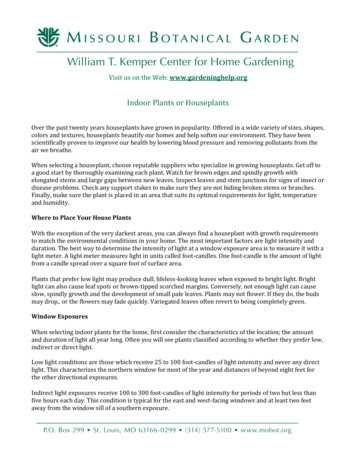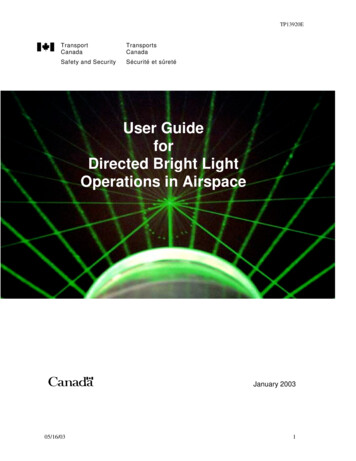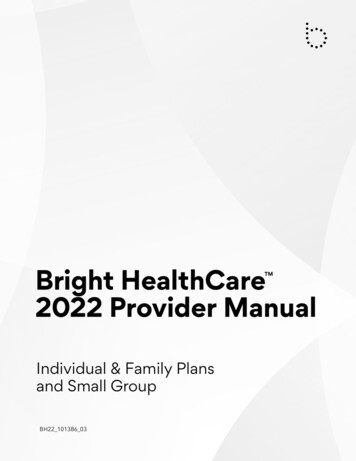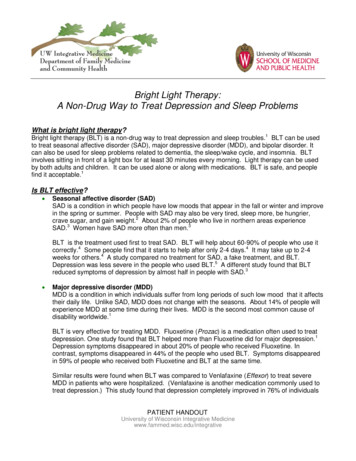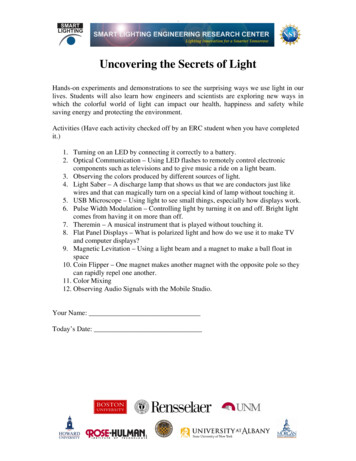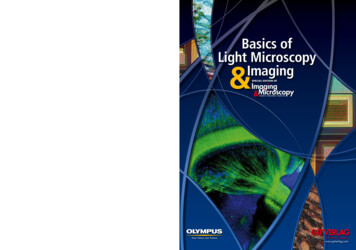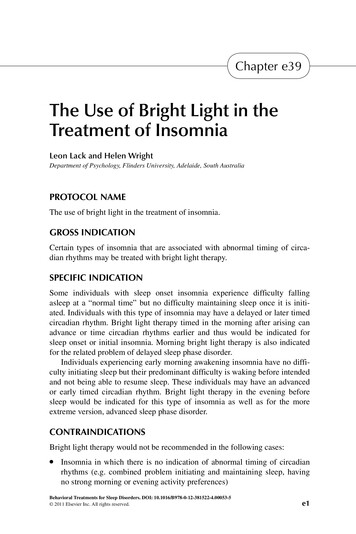
Transcription
Chapter e39The Use of Bright Light in theTreatment of InsomniaLeon Lack and Helen WrightDepartment of Psychology, Flinders University, Adelaide, South AustraliaPROTOCOL NAMEThe use of bright light in the treatment of insomnia.GROSS INDICATIONCertain types of insomnia that are associated with abnormal timing of circadian rhythms may be treated with bright light therapy.SPECIFIC INDICATIONSome individuals with sleep onset insomnia experience difficulty fallingasleep at a “normal time” but no difficulty maintaining sleep once it is initiated. Individuals with this type of insomnia may have a delayed or later timedcircadian rhythm. Bright light therapy timed in the morning after arising canadvance or time circadian rhythms earlier and thus would be indicated forsleep onset or initial insomnia. Morning bright light therapy is also indicatedfor the related problem of delayed sleep phase disorder.Individuals experiencing early morning awakening insomnia have no difficulty initiating sleep but their predominant difficulty is waking before intendedand not being able to resume sleep. These individuals may have an advancedor early timed circadian rhythm. Bright light therapy in the evening beforesleep would be indicated for this type of insomnia as well as for the moreextreme version, advanced sleep phase disorder.CONTRAINDICATIONSBright light therapy would not be recommended in the following cases: Insomnia in which there is no indication of abnormal timing of circadianrhythms (e.g. combined problem initiating and maintaining sleep, havingno strong morning or evening activity preferences)Behavioral Treatments for Sleep Disorders. DOI: 10.1016/B978-0-12-381522-4.00053-5 2011 Elsevier Inc. All rights reserved.e1
e2 Chapter e39The Use of Bright Light in the Treatment of InsomniaIndividuals with eye problems such as cataractsIndividuals who have a light sensitivity due to medical/medication reasonsRATIONALE FOR INTERVENTIONCircadian rhythms exert a very strong effect on our subjective and objectivesleepiness, that is, how sleepy we feel, how quickly we will fall asleep, and thetime we wake. In a person with a normally timed circadian rhythm the sleepperiod occurs between about 11 p.m. and 7 a.m. Maximum circadian sleepiness occurs between 1 a.m. to 6 a.m., associated with decreased core body temperature and high melatonin levels (Figure e39.1). Wake-up time usually occurssoon after the body temperature begins to rise, that is, about 7 a.m. Figuree39.1 also shows that there are two circadian periods that surround the sleepconducive zone during which sleep may be inhibited: the “wake maintenancezone”, in normal sleepers occurs between 6–10 p.m. and a less intense andlonger “wake-up zone” which occurs between 8 a.m. and noon.Disturbances of the relationship between the circadian rhythm and thepreferred sleep-wake pattern can lead to chronic sleeping difficulties. If individuals have a delayed (later timed) circadian rhythm their evening wakemaintenance zone may be delayed until 1 a.m. If they try to sleep at 11 p.m.sleep onset would be delayed. If the individual has to wake in the morning forsocial or work obligations at their usual time (e.g. 7 a.m.) then total sleep timewould be reduced. This can develop into chronic sleep onset insomnia. Severalnights of reduced sleep will result in daytime impairment and distress.Core bodytemperatureZZ ZZZZZ ZZZZZZ ZZ ZSleep zoneZ ZZZ ZWake-upzoneWakemaintenancezoneMelatonin level12 noon4 pm8 pm12 am4 am8 am12 noonClock timeFIGURE e39.1 This illustrates the circadian rhythms of core body temperature and melatoninfor a good sleeper normally sleeping between 11 p.m. and 7 a.m. This produces a circadian sleepyzone during that sleep period but is bracketed by two alert zones; a wake maintenance zone fromabout 6–9 p.m. and a wake-up zone from about 8 a.m. to 12 noon. If the circadian system becomesdelayed in time, the wake maintenance zone will be delayed and can inhibit sleep onset and leadto sleep onset insomnia. If the circadian system becomes advanced (timed earlier), the wake-upzone will be advanced and can lead to early morning awakening insomnia.
Chapter e39The Use of Bright Light in the Treatment of Insomniae3Conversely, some individuals may have an early timed or phase advancedcircadian rhythm that would result in their “wake-up zone” occurring asearly as 3 a.m., thus curtailing sleep earlier than desired. This too can lead toa reduced total sleep time and daytime impairment and the development ofchronic morning awakening insomnia.Studies over the past 20 years have shown that appropriately timed brightlight can change the timing of the circadian rhythm. For example, morningbright light will change the phase of the circadian rhythm to an earlier time.Therefore this could be a suitable therapy for those individuals with sleeponset insomnia who are having difficulty falling asleep until quite late (e.g.midnight or later). With an earlier timed circadian rhythm, they may be able tofall asleep and wake earlier following a regime of morning light therapy.Bright light administered in the evening has been shown to delay the circadian rhythm. Therefore, using a regime of evening bright light therapy, individuals experiencing early morning awakening insomnia may be able to delaytheir sleep/wake cycle resulting in a later wake up time. Overall total sleeptime would increase and daytime functioning would improve.STEP-BY-STEP DESCRIPTION OF PROCEDURES (HOW TO)Bright light therapy can be administered using outdoor sunlight or artificialbright indoor lighting. Normal indoor lighting (about 100 lux) is of insufficientintensity. Research has demonstrated that light of about 1,000 lux or more isefficacious at phase changing the circadian rhythm. More recent research hasalso shown that it is the shorter wavelength blue light that is the most effective wavelength in changing the timing of the circadian rhythm. There aremany commercial light devices available. To be effective, light needs to enterthe eyes, however staring at the light source is not necessary and with somedevices is NOT RECOMMENDED. Clients may eat a meal, watch television,read, work on a computer or do other activities while receiving the light stimulus in their visual field.Pre TherapyClients with insomnia are asked to complete a one or two week diary that documents their bedtimes, lights out and estimated sleep onset times, timing andlengths of any night time awakenings and final wake up time. Total sleep timeand total time in bed can be calculated from this information. Food, caffeine andalcohol intake should also be recorded. It is necessary to determine the client’sactual sleep/wake schedule taking into account their work/school/social commitments rather than to rely upon a rough verbal estimate of their normal sleep.The client’s preferred or target sleep period should be determined realisticallytaking into account their work/social commitments and motivation for change.
e4Chapter e39The Use of Bright Light in the Treatment of InsomniaThe ideal protocol would be:Sleep Onset Insomnia1. The first step is to evaluate the timing of the client’s circadian rhythm andsleep/wake pattern when the choice of sleep period is self-selected andwithout any interference of commitments. For two consecutive nights askthe client to go to bed when feeling sleepy and note the sleep onset andspontaneous wake up time. This will give you an indication of their endogenous (internal) circadian phase.2. Start the first light therapy session from this spontaneous wake up time.3. Wake up time and bright light exposure is then advanced 30 minutes eachmorning until preferred wake up time is reached (See Figure e39.2). Thisregime is flexible, for example, a client may wish to commence withsmaller (15 minute) advances or may wish to stay at a particular wakeup time for 2 to 3 days before continuing with the advancing of wake uptime. This can occur if the client is finding the protocol difficult. It cantake between 7 to 14 days to reach the desired sleep schedule. It is recommended to continue for another week of morning bright light therapy afterthe desired sleep schedule has been reached.4. Although outdoor morning light is ideal, an artificial light device may beneeded during darker or inclement months. The client should receive thevisual light stimulation immediately on awakening and for up to an hour ifpossible.5. It is recommended that clients do not wear very dark or blue blocking sunglasses in the mornings.Go to bed when sleepy Sleep periodGo to bed when sleepy Sleep periodGo to bed when sleepy Sleep periodGo to bed when sleepy Sleep periodGo to bed when sleepy Sleep periodGo to bed when sleepy Sleep periodGo to bed when sleepy Sleep periodGo to bed when sleepy Sleep periodGo to bed when sleepy Sleep periodWake up to lightWake up 30 minutes earlierWake up 30 minutes earlierWake up 30 minutes earlierWake up 30 minutes earlierWake up 30 minutes earlierMaintain target wake timeMaintain target wake timeMaintain target wake time Dim light and relaxing activity in evening Morning bright lightFIGURE e39.2 Illustrated is the use of morning bright light treatment and stimulus control therapy for sleep onset insomnia. In this case wake up time needed to be advanced by 2.5 hours overfive mornings resulting in a more gradual advance of sleep onset time.
Chapter e39The Use of Bright Light in the Treatment of Insomniae56. Sleeping-in later than the scheduled time should be avoided. It can delaythe circadian rhythms and cause a relapse. That is, maintain a consistentwake up time, even on weekends.7. In the hour or two before bedtime dim light and a relaxing activity is recommended, i.e. no computer work.8. Stimulus control therapy instructions should be followed before bedtime toensure the client is not lying in bed awake for long periods.Early Morning Awakening Insomnia1. Clients are asked to keep active in the evening and to stay in bright ambientlight. For example, they are encouraged to eat dinner, do any housework,watch TV or other activities in a well lit room, preferably under fluorescentlighting. It is recommended that clients be exposed to evening bright lightuntil as late as possible. An ideal regime would be for the client to stayup and be exposed to bright light until about midnight on two consecutiveevenings and then until their target bedtime for a further 5 to 7 days. It isusually necessary to use an artificial light source at this time of night toprovide sufficient intensity of light. Again, clients can sit in front of thelight device while watching TV, reading, or working on a computer.2. It is recommended that clients avoid bright light in the mornings and mayneed to wear dark glasses or blue light blocking glasses if they wish to gooutside in the first hours after awakening. Blue blocking glasses will have ared or “smokey” tinge and reduce transmission of blue light.3. If clients are experiencing night time awakenings, then bedtime restrictiontherapy may also be recommended with evening bright light exposure untiltheir new bedtime as part of the reduced bed period treatment.POSSIBLE MODIFICATIONS/VARIANTSClients with an advanced circadian rhythm may not be able to tolerate stayingup past their usual bedtime. In this case, the evening light therapy regime maybe carried out over a longer time period (e.g. 2 to weeks).PROOF OF CONCEPT/SUPPORTING DATA/EVIDENCE BASEConsiderable evidence has linked circadian rhythm phases to wake maintenance and wake up zones which inhibit sleep [1–3].There is increasing evidence that individuals with sleep onset insomniamay have a delayed circadian rhythm [4–6] and, conversely, those with earlymorning awakening insomnia have an advanced rhythm [7–9].Appropriately timed bright light will re-time the circadian rhythm [10,11].Morning bright light has been shown to advance the circadian rhythm of subjectswith sleep onset insomnia [12] and delayed sleep phase disorder [4,13]. Evening
e6Chapter e39The Use of Bright Light in the Treatment of Insomniabright light has been shown to effectively delay the circadian rhythm and sleep/wake pattern of those with early morning awakening insomnia [9,14,15].REFERENCES[1] D.J. Dijk, C.A. Czeisler, Paradoxical timing of the circadian rhythm of sleep propensityserves to consolidate sleep and wakefulness in humans, Neurosci. Lett. 166 (1994) 63–68.[2] L.C. Lack, K. Lushington, The rhythms of human sleep propensity and core body temperature, J. Sleep Res. 5 (1) (1996) 1–11.[3] S. Strogatz, R. Kronauer, C.A. Czeisler, Circadian pacemaker interferes with sleep onset atspecific times each day: role in insomnia, Am. J. Physiol. 253 (1987) R172–178.[4] L. Lack, T. Bramwell, H. Wright, Morning bright blue light can advance the melatoninrhythm in mild delayed sleep phase syndrome, Sleep Biol. Rhythms 5 (2007) 78–80.[5] M. Morris, L. Lack, D. Dawson, Sleep-onset insomniacs have delayed temperaturerhythms, Sleep 13 (1990) 1–14.[6] H. Wright, L. Lack, R. Bootzin, Relationship between dim light melatonin onset and thetiming of sleep in sleep onset insomniacs, Sleep Biol. Rhythms 4 (2006) 78–80.[7] C.R. Jones, S.S. Campbell, S.E. Zone, F. Cooper, A. DeSano, P.J. Murphy, et al., Familialadvanced sleep-phase syndrome: A short-period circadian rhythm variant in humans,Nature 5 (1999) 1062–1065.[8] L.C Lack, J.D Mercer, H.R. Wright, Circadian rhythms of early morning awakening insomniacs, J. Sleep Res. 5 (1996) 211–219.[9] L. Lack, H. Wright, The effect of evening bright light in delaying the circadian rhythms andlengthening the sleep or early morning awakening insomniacs, Sleep 16 (1993) 436–443.[10] C.A. Czeisler, R.E. Kronauer, J.S. Allan, J.F. Duffy, M.E Jewett, E.N Brown, et al., Brightlight induction of strong (Type 0) resetting of the human circadian pacemaker, Science 244(1989) 1328–1333.[11] D.S. Minors, J.M. Waterhouse, A. Wirz-Justice, A human phase-response curve to light,Neurosci. Lett. 133 (1991) 36–40.[12] L. Lack, H. Wright, D. Paynter, The treatment of sleep onset insomnia with bright morninglight, Sleep Biol. Rhythms 5 (2007) 173–179.[13] N.E. Rosenthal, J.R. Joseph-Vanderpool, A.A. Levendosky, S.H. Johnston, R. Allen,K.A. Kelly, et al., Phase-shifting effects of bright morning light as treatment for delayedsleep phase syndrome, Sleep 13 (1990) 354–361.[14] S.S. Campbell, D. Dawson, M.W. Anderson, Alleviation of sleep maintenance insomniawith timed exposure to bright light, J. Am. Geriatr. Soc. 41 (8) (1993) 829–836.[15] L. Lack, H. Wright, K. Kemp, S. Gibbon, The treatment of early-morning awakeninginsomnia with 2 evenings of bright light, Sleep 28 (2005) 616–623.RECOMMENDED READINGSL. Lack, H. Wright, Treating chronobiological components of chronic insomnia, Sleep Med. 8(2007) 637–644.L. Lack, H. Wright, Circadian Rhythm Disorders I: Phase-advanced and phase delayed disorders,in: C. Espie, C. Morin, (Eds.), Oxford Handbook of Sleep and Sleep Disorders (in press),Oxford Library of Psychology: Oxford University Press.
Bright light therapy can be administered using outdoor sunlight or artificial bright indoor lighting. Normal indoor lighting (about 100 lux) is of insufficient intensity. Research has demonstrated that light of about 1,000 lux or more is efficacious at phase changing the circadian rhythm. More recent research has

